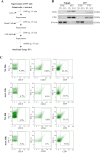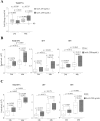ActivinA modulates B-acute lymphoblastic leukaemia cell communication and survival by inducing extracellular vesicles production
- PMID: 38992199
- PMCID: PMC11239915
- DOI: 10.1038/s41598-024-66779-3
ActivinA modulates B-acute lymphoblastic leukaemia cell communication and survival by inducing extracellular vesicles production
Abstract
Extracellular vesicles (EVs) are a new mechanism of cellular communication, by delivering their cargo into target cells to modulate molecular pathways. EV-mediated crosstalk contributes to tumor survival and resistance to cellular stress. However, the role of EVs in B-cell Acute Lymphoblastic Leukaemia (B-ALL) awaits to be thoroughly investigated. We recently published that ActivinA increases intracellular calcium levels and promotes actin polymerization in B-ALL cells. These biological processes guide cytoskeleton reorganization, which is a crucial event for EV secretion and internalization. Hence, we investigated the role of EVs in the context of B-ALL and the impact of ActivinA on this phenomenon. We demonstrated that leukemic cells release a higher number of EVs in response to ActivinA treatment, and they can actively uptake EVs released by other B-ALL cells. Under culture-induced stress conditions, EVs coculture promoted cell survival in B-ALL cells in a dose-dependent manner. Direct stimulation of B-ALL cells with ActivinA or with EVs isolated from ActivinA-stimulated cells was even more effective in preventing cell death. This effect can be possibly ascribed to the increase of vesiculation and modifications of EV-associated microRNAs induced by ActivinA. These data demonstrate that ActivinA boosts EV-mediated B-ALL crosstalk, improving leukemia survival in stress conditions.
Keywords: ActivinA; B-cell acute lymphoblastic leukaemia; Cell survival; Extracellular vesicles; Intercellular communication; Microenvironment.
© 2024. The Author(s).
Conflict of interest statement
The authors declare no competing interests.
Figures





Similar articles
-
ActivinA: a new leukemia-promoting factor conferring migratory advantage to B-cell precursor-acute lymphoblastic leukemic cells.Haematologica. 2019 Mar;104(3):533-545. doi: 10.3324/haematol.2018.188664. Epub 2018 Sep 27. Haematologica. 2019. PMID: 30262563 Free PMC article.
-
Exploring cell-derived extracellular vesicles in peripheral blood and bone marrow of B-cell acute lymphoblastic leukemia pediatric patients: proof-of-concept study.Front Immunol. 2024 Aug 21;15:1421036. doi: 10.3389/fimmu.2024.1421036. eCollection 2024. Front Immunol. 2024. PMID: 39234258 Free PMC article.
-
Vorinostat impairs the cancer-driving potential of leukemia-secreted extracellular vesicles.J Transl Med. 2025 Apr 10;23(1):421. doi: 10.1186/s12967-025-06361-1. J Transl Med. 2025. PMID: 40211278 Free PMC article.
-
Extracellular vesicle communication pathways as regulatory targets of oncogenic transformation.Semin Cell Dev Biol. 2017 Jul;67:11-22. doi: 10.1016/j.semcdb.2017.01.003. Epub 2017 Jan 8. Semin Cell Dev Biol. 2017. PMID: 28077296 Review.
-
Cell-to-cell communication: microRNAs as hormones.Mol Oncol. 2017 Dec;11(12):1673-1686. doi: 10.1002/1878-0261.12144. Epub 2017 Oct 26. Mol Oncol. 2017. PMID: 29024380 Free PMC article. Review.
Cited by
-
Dysregulation of the Bone Marrow Microenvironment in Pediatric Tumors: The Role of Extracellular Vesicles in Acute Leukemias and Neuroblastoma.Int J Mol Sci. 2025 Jun 4;26(11):5380. doi: 10.3390/ijms26115380. Int J Mol Sci. 2025. PMID: 40508186 Free PMC article. Review.
-
Harnessing the power of proteins in modulation of miRNAs for targeting Iron deficiency Anemia: Opinion for future implications and strategies.Front Nutr. 2025 Jan 27;12:1535498. doi: 10.3389/fnut.2025.1535498. eCollection 2025. Front Nutr. 2025. PMID: 39931366 Free PMC article. Review.
-
Development of a 3D ex vivo model of brain-leukemia interaction to study the role of activin A in the central nervous system microenvironment.Sci Rep. 2025 May 29;15(1):18915. doi: 10.1038/s41598-025-03877-w. Sci Rep. 2025. PMID: 40442333 Free PMC article.
References
-
- Bashir M, Damineni S, Mukherjee G, Kondaiah P. Activin-A signaling promotes epithelial–mesenchymal transition, invasion, and metastatic growth of breast cancer. npj Breast Cancer. 2015;1:1–13. doi: 10.1038/npjbcancer.2015.7. - DOI
MeSH terms
Substances
Grants and funding
LinkOut - more resources
Full Text Sources

